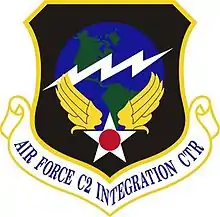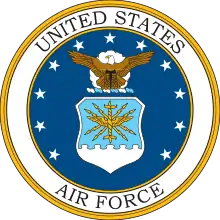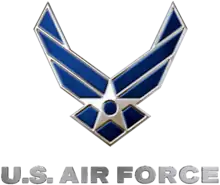Air Force Command and Control Integration Center
The Air Force Command and Control Integration Center (AFC2IC) was an Air Combat Command (ACC) Field Operating Agency (FOA) responsible for innovating, designing, developing, integrating, and sustaining command and control (C2) capabilities. The headquarters was a tenant unit of Langley Air Force Base, with several outlying support locations.[2]
| Air Force Command and Control Integration Center[1] | |
|---|---|
 AF C2 Integration Center Shield | |
| Active | 1 August 1997 – 16 December 2013 |
| Country | United States |
| Branch | United States Air Force |
| Role | Command and Control |
| Garrison/HQ | Langley Air Force Base |
| Decorations | |
| Commanders | |
| Current commander | SES Stan Newberry |
The AFC2IC deactivated in 2013. It had gone through numerous name and organizational changes – aligned at one time under the Air Staff – since 1997 including Aerospace Command and Control Agency (ASC2A), Air Force Command, Control, Intelligence, Surveillance, and Reconnaissance Center (AFC2ISRC), and Global Cyberspace Integration Center (GCIC) but maintained essentially the same mission throughout.
History
The center was initially established as the Air and Space Command and Control Agency (ASC2A) on 1 August 1997. The agency included the two major field units that became the Air Force C2 Battlelab and the Air Force C2 Training and Innovation Group. The Tactical Air Forces Interoperability Group (TAFIG) was a predecessor organization under Tactical Air Command. It was focused primarily on tactical interoperability and was a leader in the improvement and integration of Tactical Data Links and message text formats, a responsibility AFC2IC carries on today. Intelligence, surveillance, and reconnaissance (ISR) was added to the agency's mission and it was re-designated the Aerospace Command and Control Agency (AC2A) on 15 September 1998. A few months later, on 1 January 1999, the AC2A again expanded its mission, taking on responsibilities such as unmanned aerial platforms, and was officially re-designated the Aerospace Command and Control & Intelligence, Surveillance and Reconnaissance Center (AC2ISRC). The Center eventually gained the Air Force Unmanned Aerial Vehicle Battlelab, and fifteen operating locations intended to network the C2 mission.[1]
In 2002, the Center underwent its most profound change organizationally since its creation. On 15 March 2002 the Center was re-designated the Air Force Command and Control & Intelligence, Surveillance and Reconnaissance Center (AFC2ISRC) and realigned as a field operating agency under the Deputy Chief of Staff for Warfighting Integration (AF/XI); a year later XI was transferred to report to the Secretary of the AF, and the office symbol was changed to SAF/XC).[1]
On 2 April 2007, the AFC2ISRC was re-designated the Air Force Global Cyberspace Integration Center (AF GCIC) signifying an Air Force cultural shift to the cyberspace domain[1] while still maintaining its responsibilities for C2 integration.
On 16 June 2010, the center was realigned under the ACC Directorate of Requirements (A8) and named the Air Force C2 Integration Center (AFC2IC).[3]
In January 2013, the Commander of Air Combat Command announced his intention to reorganize the headquarters staff to formulate a consolidated Planning, Programming and Requirements Directorate (A5/8/9). As part of this planned reorganization, AFC2IC would be deactivated and its functions and personnel merged into the new A5/8/9 Directorate. An informal closing ceremony for AFC2IC was held on 16 December 2013, officiated by the last Center Director, SES Stan Newberry. Several former leadership figures from the Center's long and productive history were in attendance.
Air Operations Center
The Aerospace Operation Center(AOC) (later Air Operations Center) has been a central mission for the center. Tremendous efforts led the AOC to be declared a weapon system on 8 September 2000. The first Combined Aerospace Operations Center-Experimental (CAOC-X) was built at Langley Air Force Base. The next CAOC built stood up over the following year at Prince Sultan Air Base, Saudi Arabia, and became the "premier C2 weapon system in the world."
Leading the AOC innovation effort through large-scale experiments that rapidly delivered capabilities onto the battlefield, the Center's efforts collectively marked a seven-year period of modernizing, standardization, and seamless integration.
Joint Expeditionary Force Experiment
Starting out in 1998 as the Air Force's [single service] Expeditionary Force eXperiment (EFX 98), this experimentation and testing venue allowed innovators and formal acquisition programs to try out new equipment, tactics, procedures in a large-scale field environment. The equipment tested included C3 systems, vehicles, aircraft, software, radios, etc. focused on enhancing information/ISR collection and exchange, and improving interoperability. The venue quickly grew to include multiple services and nations and was redesignated The Joint Expeditionary Force eXperiment by 1999 (JEFX 99). It was subsequently conducted biannually in 2000, 2002, 2004, 2006, 2008 with particular emphasis on C2 and improving the "Kill Chain". More recently, it was supposed to be downsized to focus on specific areas for improvement in C2 integration and conducted on a smaller scale on a quarterly basis with occasional large-scale events.
Tactical Networks Integration
Tactical Data Links and Voice Networks are essential to C2 and situational awareness of forces in the battlespace from the tactical edge to the Joint Task Force. AFC2IC has been leading the way in integrating these networks for the Air Force, other services, and other nations throughout its history including Link 11 and Link 16 improvements; TDL network management, integrators and gateways; Joint Tactical Radio System; and emerging developments in Airborne Networking. [4]
Commanders/Directors
- Stan C. Newberry, January 2008 – 2013
- Brig Gen Mike H. McClendon, July 2007 – January 2008
- Maj Gen Kevin J. Kennedy, June 2006 – July 2007
- Maj Gen Tommy F. Crawford, July 2003 – June 2006
- Maj Gen Robert F. Behler, Aug 2001 – July 2003
- Maj Gen Gerald F. Perryman, May 1999 – August 2001
- Maj Gen John W ("Little") Hawley , July 1997 – June 1999
See also
References
Notes
- "AFGCIC Library". Archived from the original on 12 June 2009. Retrieved 18 May 2009.
- "Archived copy". Archived from the original on 17 November 2011. Retrieved 1 December 2011.CS1 maint: archived copy as title (link)
- --~~~~"Archived copy" (PDF). Archived from the original (PDF) on 16 February 2013. Retrieved 2 November 2016.CS1 maint: archived copy as title (link)
- "Archived copy" (PDF). Archived from the original (PDF) on 16 February 2013. Retrieved 2 November 2016.CS1 maint: archived copy as title (link)


